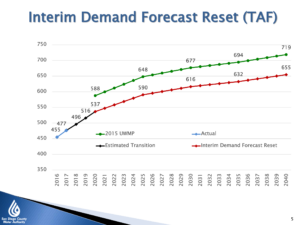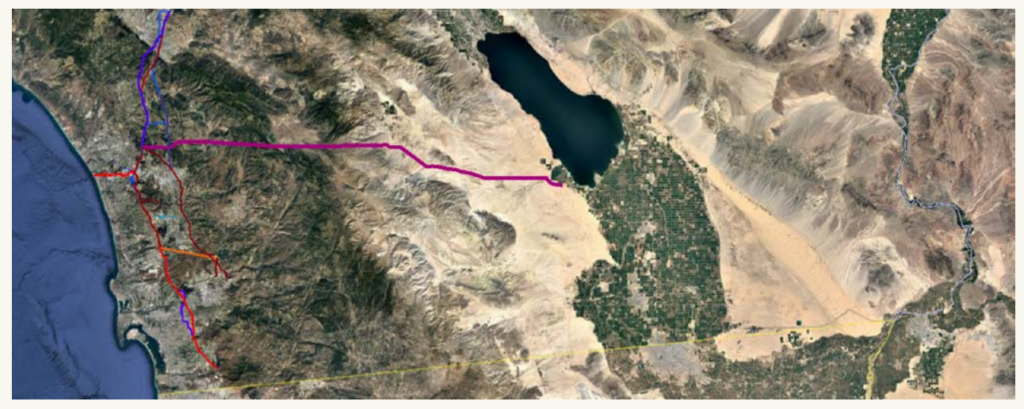I’m puzzling over the San Diego County Water Authority’s pursuit of a new Colorado River pipeline.
I’ve been puzzling for a while, given a that it would be really expensive and that a really big pipe (aqueduct) already exists to carry the water to San Diego. My puzzlement was goosed by a report that surfaced last week at a board meeting of one of its member agencies suggesting that the general managers of agencies representing the majority of the Water Authority’s actual water-using member agencies don’t seem to want it.
The puzzle
In 2018, the San Diego County Water Authority did something striking, given the water management community’s tendency toward inflated future demand projections. It calculated something it called a “demand reset”, involving a fresh look at demand projections published just two years earlier.

rethinking San Diego’s water needs
Demand calculations published in the agency’s state-mandated Urban Water Management Plan, the “demand reset” analysis found, had inflated near-term water demands (water needed by 2020) by 9 percent.
So how has the new “demand reset” analysis held up? Actual water use in 2019 was 14 percent lower than the projection made in 2018, just one year earlier.
To be clear – the new study, done out of fears that the last study had overestimated demand, itself overestimated demand.
This has been going on for a while. Since its 2002 peak, total San Diego County Water Authority use has declined by 27 percent, even as the county’s population has risen by 15 percent. See decoupling.
I was grinding through these numbers as I puzzled over the San Diego County Water Authority’s scheme to build a new pipeline across the desert to carry its supplies of Colorado River water – ~280,000 acre feet a year of water it got through various agricultural efficiency projects in Imperial Valley.
That water currently is delivered via exchange agreement through the existing Metropolitan Water District Colorado River Aqueduct. So San Diego already has a way to get the water. But an arcane legal and financial and cultural feud (c’mon L.A., know you hate the Padres) between the San Diego County Water Authority and the Los Angeles-based Metropolitan Water District of Southern California has led the San Diego County Water Authority to pursue a pipeline of its own, so that it would no longer be beholden to Met.
I’ve been careful in my language here to talk about “the San Diego County Water Authority”, rather than “San Diego” writ large. The Water Authority is a creation of state law that serves as a water wholesaler and system integrator across territory served by 24 member agencies, large and small. As is often the case with regional water authorities of this sort, its board of directors is made up of representatives of each of the member agencies.

Conceptual map for possible routes for a new San Diego pipeline to carry Colorado River water
In the summer of 2019, on a trip to Imperial Valley to gather stuff for a new book I’m writing hoping to start working on again when the pandemic fog clears, I heard a fascinating presentation about the project from San Diego County Water Authority Assistant General Manager Dan Denham to the Imperial Irrigation District board. Denham laid out the Water Authority’s basic argument – that with anticipated increases in the cost of getting its water through the existing Metropolitan system, it makes sense for the Water Authority to consider building its own pipe. In a net present value calculation, the Water Authority has been arguing, it would be cheaper. (The minutes are here if you’re curious, the questions were interesting.)
Here’s the fresh part of puzzle.
The idea that this is cost effective in the long run, being pushed hard by San Diego County Water Authority management, does not seem to be shared by the authority’s member agencies. 18 of the 24 member agencies, representing by my calculation 89 percent of the Authority’s water use, went out and hired their own consultants to take an independent look at the numbers. Their conclusion (which surfaced last week at a meeting of the Vallecitos Water District board, the report starts on pdf page 82):
The Draft Study’s finding that the project is economically competitive with other supply and transportation options is not reasonable. We find the project to be substantially more costly than other options.
Dueling consultants’ reports followed, and I’m not going to wade into the question is which team is right. I will note, rather, that the managers of the 18 water agencies (including the City of San Diego, by far the region’s largest water user) were sufficiently concerned about the numbers coming out of the Water Authority that they went out and hired their own consultant.
San Diego’s dream of its own Colorado River pipeline has been around since the beginning of water development in the region. In its current incarnation, the project has been at least somewhat actively pursued since 1998. So it’s probably never going to go away. But I’m adding this to my “yeah, but it also probably will never be built” list.
(H/t to Voice of San Diego’s Ry Rivard for his work on this topic over a number of years.)

SDCWA seems to see that it has incentive to pursue expensive projects (ocean desal and another Colorado R aqueduct) that might help suppress MWDSC’s rates for wheeling Colorado River water to them.
Excellent summary John. It is puzzling indeed. Essentially the concept is to pursue a huge multi-billion dollar project that takes generations to provide positive financial returns based on predictions of future conveyance costs charged by another utility – MWD. The financial forecasts hinge on predictions of cost escalators and a sensitivity analysis shows that very small changes in escalation rates have huge financial impacts. As I always say, if you are going to make a bet on future utility rates of any type, make it a small bet. This is a really big bet, not just for the people making it but for their kids, grandchildren, and great grandchildren.
Oh, and there is the CEQA thing too,,,,
Pingback: CRWCD Water News Drop 5/21 - Colorado River District